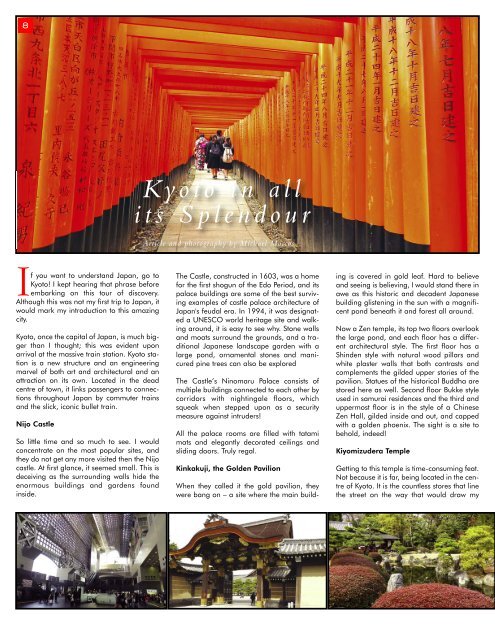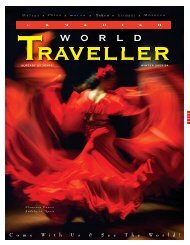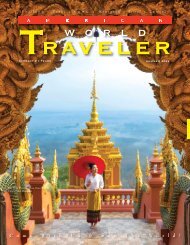Canadian World Traveller Summer 2019 Issue
Now in our 17th year of publishing, Canadian World Traveller explores the culture and history of worldwide destinations, sharing the adventure of discovery with our readers and motivating them to make their travel dreams a reality. Published quarterly, CWT helps sophisticated, independent Canadian travellers choose their next destination by offering a lively blend of intelligent, informative articles and tantalizing photographic images from our World’s best destinations, cruises, accommodations and activities to suit every traveller's taste.
Now in our 17th year of publishing, Canadian World Traveller explores the culture and history of worldwide destinations, sharing the adventure of discovery with our readers and motivating them to make their travel dreams a reality. Published quarterly, CWT helps sophisticated, independent Canadian travellers choose their next destination by offering a lively blend of intelligent, informative articles and tantalizing photographic images from our World’s best destinations, cruises, accommodations and activities to suit every traveller's taste.
Create successful ePaper yourself
Turn your PDF publications into a flip-book with our unique Google optimized e-Paper software.
8<br />
Kyoto in all<br />
its Splendour<br />
Article and photography by Michael Morcos<br />
If you want to understand Japan, go to<br />
Kyoto! I kept hearing that phrase before<br />
embarking on this tour of discovery.<br />
Although this was not my first trip to Japan, it<br />
would mark my introduction to this amazing<br />
city.<br />
Kyoto, once the capital of Japan, is much bigger<br />
than I thought; this was evident upon<br />
arrival at the massive train station. Kyoto station<br />
is a new structure and an engineering<br />
marvel of both art and architectural and an<br />
attraction on its own. Located in the dead<br />
centre of town, it links passengers to connections<br />
throughout Japan by commuter trains<br />
and the slick, iconic bullet train.<br />
Nijo Castle<br />
So little time and so much to see. I would<br />
concentrate on the most popular sites, and<br />
they do not get any more visited then the Nijo<br />
castle. At first glance, it seemed small. This is<br />
deceiving as the surrounding walls hide the<br />
enormous buildings and gardens found<br />
inside.<br />
The Castle, constructed in 1603, was a home<br />
for the first shogun of the Edo Period, and its<br />
palace buildings are some of the best surviving<br />
examples of castle palace architecture of<br />
Japan's feudal era. In 1994, it was designated<br />
a UNESCO world heritage site and walking<br />
around, it is easy to see why. Stone walls<br />
and moats surround the grounds, and a traditional<br />
Japanese landscape garden with a<br />
large pond, ornamental stones and manicured<br />
pine trees can also be explored<br />
The Castle’s Ninomaru Palace consists of<br />
multiple buildings connected to each other by<br />
corridors with nightingale floors, which<br />
squeak when stepped upon as a security<br />
measure against intruders!<br />
All the palace rooms are filled with tatami<br />
mats and elegantly decorated ceilings and<br />
sliding doors. Truly regal.<br />
Kinkakuji, the Golden Pavilion<br />
When they called it the gold pavilion, they<br />
were bang on – a site where the main building<br />
is covered in gold leaf. Hard to believe<br />
and seeing is believing, I would stand there in<br />
awe as this historic and decadent Japanese<br />
building glistening in the sun with a magnificent<br />
pond beneath it and forest all around.<br />
Now a Zen temple, its top two floors overlook<br />
the large pond, and each floor has a different<br />
architectural style. The first floor has a<br />
Shinden style with natural wood pillars and<br />
white plaster walls that both contrasts and<br />
complements the gilded upper stories of the<br />
pavilion. Statues of the historical Buddha are<br />
stored here as well. Second floor Bukke style<br />
used in samurai residences and the third and<br />
uppermost floor is in the style of a Chinese<br />
Zen Hall, gilded inside and out, and capped<br />
with a golden phoenix. The sight is a site to<br />
behold, indeed!<br />
Kiyomizudera Temple<br />
Getting to this temple is time-consuming feat.<br />
Not because it is far, being located in the centre<br />
of Kyoto. It is the countless stores that line<br />
the street on the way that would draw my
















